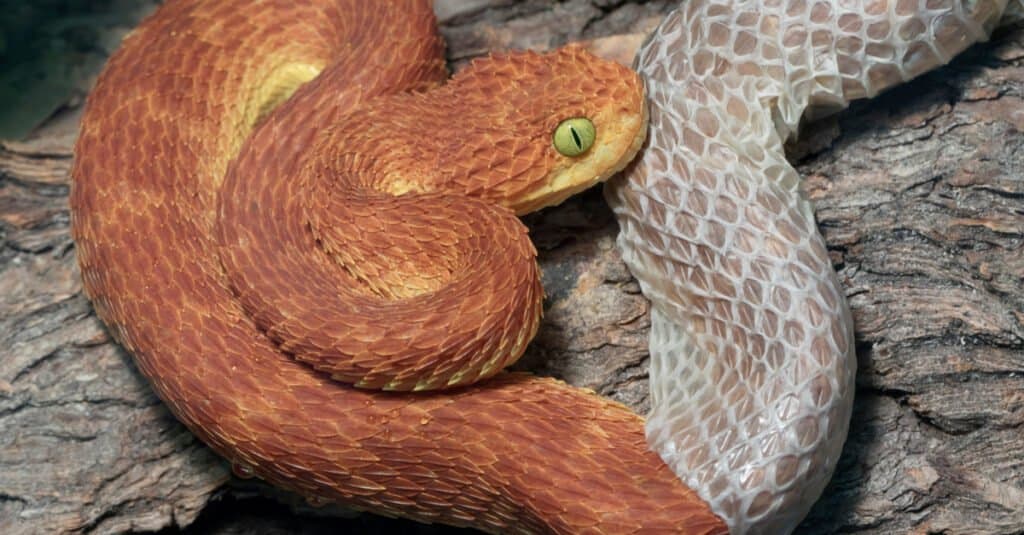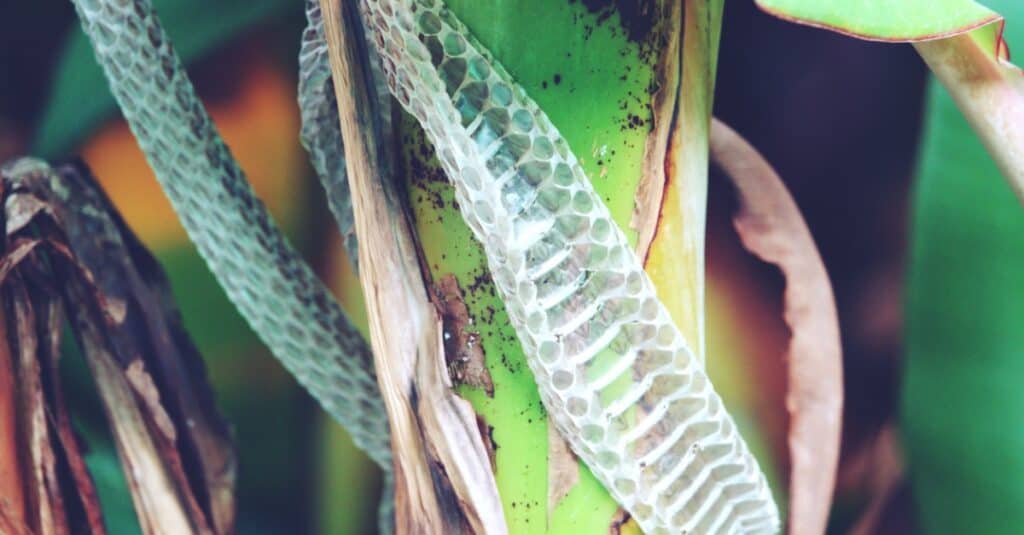Snakes have dry, smooth skin, covered in a network of overlapping scales. Contrary to popular belief, it’s neither wet nor slippery. The skin serves many critical functions: it provides locomotion, protects the body, retains moisture, aids in camouflage, warns away predators (as in the case of a rattle), and even sometimes attracts prey. Their long, limbless bodies come in a variety of different sizes and colors, but all of them share a similar feature: they shed their skin at regular intervals throughout the year.
In humans, as well as most other animals, this shedding process occurs gradually, as individual flakes are lost and then replaced by new cells. But snakes shed in a very different manner: it occurs all at once in a rather long and challenging process. Their skin is composed of two basic layers: the soft, colorful dermis below and the hard, somewhat translucent scales on top. These scales are made from keratin, the same substance as fingernails, horns, and hair. They also contain small amounts of a dark brown or black substance called melanin to protect the lower layers of the skin from the harsh rays of the sun.
You may assume that the primary purpose of the scales is to protect against predators and threats, and that is one function. However, the scales actually serve a very important locomotive function. As the snake slides its body along the ground, the scales reduce friction with the surface and therefore save a lot of energy. This means it’s necessary to always keep the scales working in excellent condition if it wants to move efficiently. In the wild, improperly shed skin could be the difference between life and death.
Snakes shed the outer layer of scales in a process called ecdysis, molting, or sloughing. It’s a very common process in invertebrates as well as some vertebrates like snakes. This article will cover some interesting facts about ecdysis: why it occurs, how it works, and what you can do to keep a pet snake healthy as it endures the process.
Why do snakes shed their skin?

©Mark_Kostich/Shutterstock.com
There are three basic reasons why snakes molt or shed their skin. The first reason is to replace old skin cells that become worn down and less effective over time; the scales need to be renewed fairly often to do their job. The second reason is that the molting process also serves the purpose of removing any dangerous parasites such as mites and ticks from the skin. The third reason (which is actually still disputed by scientists) is that it allows young snakes to grow larger with each passing molt. The number of scales remains fixed from the moment of birth and throughout the snake’s entire lifetime, but the scales themselves do become larger with age to accommodate a growing body.
Snakes only shed the upper layer of the skin and not the actual dermis, of course. This is because only the scales become worn out over time, whereas the dermis is mostly protected. Shedding in this manner appears to be an important evolutionary adaptation for some reptiles. The snake’s closest living relation, the lizard, also sheds its skin by rubbing it against an object. However, whereas the snakeskin generally comes off in a single piece, the lizard skin usually falls off in several different pieces.
How does the shedding process work?
The shedding process begins after the snake grows a new layer of skin directly beneath the old layer of keratin. The skin will open up near the mouth and peel backward along the body. Lubricating foam will start to form between the old and new layers of skin, allowing the snake to rub the old scales off against a rock or other rough object.
The entire time between the start of the shedding process and the end can last for several days or weeks, leaving the snake somewhat vulnerable and exposed, so it must find a suitable place to hide. Once the process is done, the snake will leave behind a white or brown-colored skin husk, but some species, like the Australian water python, produce rainbow-colored skin when the light hits it at a certain angle. The discarded skin leaves behind such a perfect imprint of the scales that it’s possible to determine the species from the husk alone.
The shedding process is a very important yet challenging time in the life of a snake. If you currently own a pet snake (or you’re thinking about buying one), then you should familiarize yourself with the visible signs that it’s about to start shedding, so you can learn what to do about it. At the very beginning of this important process, the snake will normally stop eating and find a safe place to hide. You may not want to disturb your snake during this time, because it can be a little more aggressive and defensive than usual. The eyes will then turn cloudy or blue on account of the eye cap (the scale over the eye) loosening up. The skin will also start to look kind of discolored and hazy. At that point, the snake will be ready to remove its old layer. Don’t worry about trying to feed it; snakes can go weeks without food.
How often do snakes shed their skin?
The frequency of ecdysis depends on numerous factors, including the snake’s age, diet, environment, and reproductive status. Of all these, age is perhaps the most important factor. Younger snakes shed their skin frequently, perhaps once every few weeks, while adults may shed their skin only a few times per year. The species of the snake also plays a significant role in the timing. For instance, an adult ball python will tend to shed once every four to six weeks, whereas an adult rat snake will only average a few molts per year. Pregnant females tend to shed more often as well; it’s sometimes actually a normal part of the gestation process. The snake also needs just the right amount of food and humidity to start shedding.
How do you prevent a pet snake from experiencing any shedding problems?

©iStock.com/amynapaloha
Ecdysis is absolutely critical to the health of any snake. While incomplete shedding is one of the most frequent problems, there are a few things you can do to ensure a successful molt. First, you should always provide a hard surface, like a rock or driftwood, which it can rub against to loosen up the skin. Sometimes, leaving out a bit of water in which the snake can soak itself will help remove some of the dead skin that won’t come off; consider lightly misting the snake as well.
Second, the cage needs to be the correct temperature and humidity, which depends on the species. It helps if you increase the humidity slightly if there are problems, but otherwise, its typical environmental conditions are fine.
Finally, owners should also take care not to handle a snake too much right before and during the process; they can be a little vulnerable to the touch and often feel stressed out. Even very calm and even-tempered snakes may not want to be handled during this time.
If your snake fails to properly shed its skin, it might be a sign of an infection, parasite, nutritional deficiency, or other medical condition. Talk with your vet to find out what’s wrong.
Next Up…
- 10 Incredible Snake Facts: Interested in one of the most feared species across the globe? Find out incredible facts that will make your eyes pop.
- Do snakes make good pets, actually?: Many people keep snakes as pets. However, do they really make good pets? Find out here.
- Are Snakes Carnivores? What Surprising Foods Do They Eat?: Lets find out about the diets and eating habits of snakes in general.
The photo featured at the top of this post is © iStock.com/Mark Kostich
Discover the "Monster" Snake 5X Bigger than an Anaconda
Every day A-Z Animals sends out some of the most incredible facts in the world from our free newsletter. Want to discover the 10 most beautiful snakes in the world, a "snake island" where you're never more than 3 feet from danger, or a "monster" snake 5X larger than an anaconda? Then sign up right now and you'll start receiving our daily newsletter absolutely free.
Thank you for reading! Have some feedback for us? Contact the AZ Animals editorial team.






